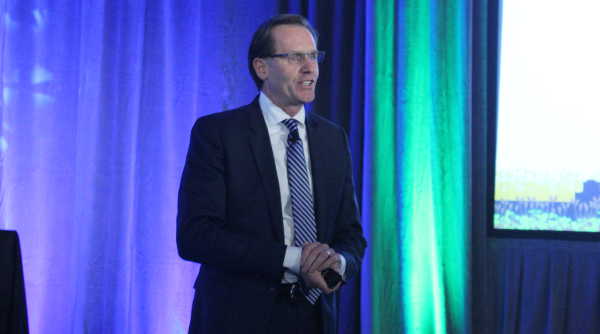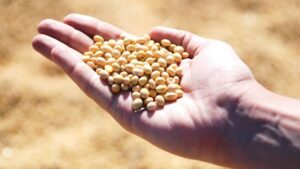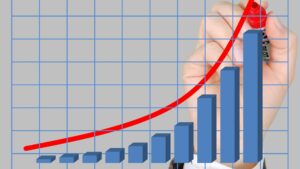2023 might face a difficult outlook, but seeds are in a good place.
There’s a beast that our economy is currently battling. The battle started in 2022, but it doesn’t look like this monster attempting to wreak havoc is ready to leave: inflation.
Inflation is currently at levels we’ve not seen in the U.S. or around the world in over 40 years, according to Dan Basse, president and economist at AgResource.
“Gone are the days of low-interest rates,” he says in his presentation at the American Seed Trade Association’s CSS & Seed Expo 2022. “Gone are the days we’ll have employees come knocking on our door. Cheap labor around China and in the U.S. has left us — so as we think about this reset, I want you to think about your investments. Think about the world ahead and how this fits into the picture of dollars and where the world sits today.”
Think about what the U.S. — and the globe — have faced within the last few years. In addition to a global health pandemic, supply chains have yet to recover. Drought and heat are becoming more of an issue as temperatures rise. Russia invaded Ukraine in February 2022, causing issues within the global grain trade. Inflation has been a major issue, along with rising interest rates, high gas and diesel prices and threats of protest on the railways.
“I’m here to say that we are not as bullish this year on corn and soybeans,” Basse says. “As we mourn the last couple of years, things have changed. The structure of this market is not the same as we had several years ago.”
What will we expect in 2023? Well, Basse doesn’t believe the outlook is bullish — instead, we’re looking at a bearish outlook as we move from 2022 to 2023.
The Numbers Game
When it comes to numbers to watch for in forecasts globally, Basse says there are a few for the seed industry to be aware of.
“If you think about corn prices, we’re going to average about $6.80 a bushel from our modeling for next year — we’re already talking about $1 less or $1.05 less,” Basse says. “If Mother Nature is normal, we can see prices stepping down, so it’s the same bullish points we had last year.”

In addition, Basse mentions in 2021, the conference heard about a looming food crisis — but as the UN would measure it (in pounds per capita, the amount of grain that’s available to each and everyone in the world), there’s no food crisis. According to Basse, the globe was close to a global food crisis, but averted it.
“One grain prevented us from going over the edge — rice,” he says. “The price of rice never rallied as much in the last year as we thought, so a lot of the impoverished rural rice kept us out of what we thought to be a crisis.”
Another trend important for the industry? This is the second year in a row where grain consumption outpaced grain production.
“Last year, one of my big concerns was raising grain crop yields — my concern is still here,” he says. “It’s a big worry, because if the world doesn’t have additional yield, what do we need to do? Bring up more acres.”
But, bringing up acres in the U.S. and globally proves to be more challenging than that.
As discussions about the world population ramp up and with the declaration of Nov. 15, 2022, as the United Nation’s Day of Eight Billion, the question remains on the mind: is the population still growing and will we have enough acreage to feed the globe?
In 2021, Basse mentioned the U.S. was ramping up to peak farmland — this year, Basse says the U.S. has reached a point in which there are no new additional arable acres of land in the U.S. — unless you take acreage out of the Conservation Reserve Program (CRP).
To bring up acres to what the globe needs, Basse says modeling shows the globe needs 22-25 million more acres in the next five years.
“Grain yield is stagnant, and that’s a lot of acres,” he says. “Where are they going to come from? We in the U.S. are at peak farmland. There’s a war going on in the Black Sea. China and Australia’s already maximized its farmland use. It can really only come from one region in the world— Latin America. Again, a lot of pressure on the Amazon resilience and those who are looking for agricultural production down there.”
Why has grain production stagnated, though? Is there an issue in current genetics?
No, Basse believes that the stagnation doesn’t come from the seed sector — it all comes back to the beast of inflation, which is causing higher input costs.
“Inflation is the biggest risk we’re seeing to crop yields over the next 10 to 20 years,” he says.
Heatflation and High Inputs
One reason inflation is causing such a problem for crop yields? It’s tied to the increase in temperatures across the globe — or “heatflation” as Basse dubbed it.
“Last summer, we saw British Columbia reach temperatures of 121 degrees — that’s about nine degrees hotter than their prior records,” he says. “The drought in Western Canada was one for the record books. Then of course, last January, extreme heat throughout southern Brazil and Argentina had their soybean drop about 30 million metric tons — a big loss for the world.”
But, those weren’t the only areas affected by heat waves. Europe was reported to be at higher temperatures across multiple countries — London at 103 F, Paris at 105 F and Amsterdam at 101 F.
“They are not set up for this kind of heat,” Basse says. “Europe is now calling this a 500-year drought.”
When heat starts to kick in, it means there’s a new yield category, and unfortunately, that low number also means the sudden need for more acres.
“When you ask me about markets — corn, soybean and wheat — we have some troubles because we are just not competitive in the world market,” Basse says. “’That gives us a demand flavor that’s somewhat bearish. Because of rising rates, the strong dollar, the world recession — the USDA is already projecting that corn, soybean and consumption annually will not change.”
How to fix it? Basse says the solution isn’t easy: we need to fix inflation.
“We need more of the supplies that are out there,” he says. “I need more bread and more oil. I need more energy and plastics and steel to make separate products.”
And though we’re seeing inflation prices in the grocery store, Basse says it’s important to look at another group suffering from inflation and high input costs: the grower customers.
Though seed costs haven’t drastically risen in recent years, other inputs surrounding growers have. The biggest one? Fertilizer prices.
“Everybody’s got their hands in [the grower’s] pockets,” Basse says. “Farmers are really anxious across the U.S. Everything costs more. Whether it’s feed, fertilizer, labor, livestock, pesticides, steel, rent, property taxes — everything is costing a little more.”
In addition, payments to farmers from the government have slowed or come to a halt, which causes more anxiety on the farm level.
“The biggest cost per acre will be fertilizer,” Basse says. “This is another year in which farmers will be spending over $150 to produce an acre of corn — which is a very lofty cost.”
Though farmers are seeing high input costs, though, Basse says in the year ahead, there shouldn’t be any problem selling corn and soybean seeds to the farmer.
“If you look at the opportunity, the farmer should plan for more corn and soybeans — he’s making about an extra $110 per acre,” Basse says. “We are forecasting this year that farmers will plant about 92 million acres of corn, which is up almost 3 million acres from last year. The farmers might still be anxious, but they have a smile on their face.”












